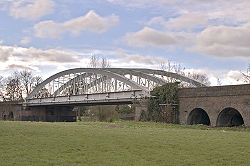Windsor Railway Bridge | |
|---|---|
 Windsor Railway Bridge, downstream side, looking towards Windsor | |
| Coordinates | 51°29′12.5″N 0°37′04.5″W / 51.486806°N 0.617917°W |
| Carries | Slough to Windsor & Eton Line |
| Crosses | River Thames |
| Locale | Windsor |
| Maintained by | Network Rail |
| Characteristics | |
| Design | Bowstring |
| Material | Wrought Iron |
| Width | 202 feet (62 m)[1] |
| Height | 17 feet 9 inches (5.41 m)[2] |
| No. of spans | 1 |
| History | |
| Designer | Brunel |
| Opened | 1849[1] |
| Location | |
 | |

Windsor Railway Bridge is a wrought iron 'bow and string' bridge in Windsor, Berkshire, crossing the River Thames on the reach between Romney Lock and Boveney Lock. It carries the branch line between Slough and Windsor.
The Windsor Railway Bridge was designed by the famed British civil engineer Isambard Kingdom Brunel, and is considered to be a forerunner to his last major work, the Royal Albert Bridge. It was built during the 1840s to carry the Slough to Windsor & Eton Line of the Great Western Railway (GWR). On account of concerns raised by the Provost of Eton College, the bridge had to cross the river while keeping it unobstructed in its entirety. Construction of the railway was subsequently authorised during 1848 and proceeded at a rapid pace, the line and bridge alike being first opened to traffic on 8 October 1849.
During the early 1860s, the original wooden approach viaducts were replaced by arched brick counterparts. During 1908, the bridge's cast iron piles were replaced by brick abutments, somewhat shortening its span to 184 ft 6in, as well as the replacement of both cross girders and rail bearers with steel equivalents.[3] While the Windsor Railway Bridge was originally built to carry a twin-track arrangement, only a single line has crossed the bridge since the railway was singled as a rationalisation measure during the 1960s. In 1975, the bridge became a Grade II* listed structure.
- ^ a b Historic England. "Details from listed building database (1319297)". National Heritage List for England. Retrieved 16 September 2008.
- ^ River Thames Alliance. Bridge heights on the River Thames.
- ^ Cite error: The named reference
eng timewas invoked but never defined (see the help page).